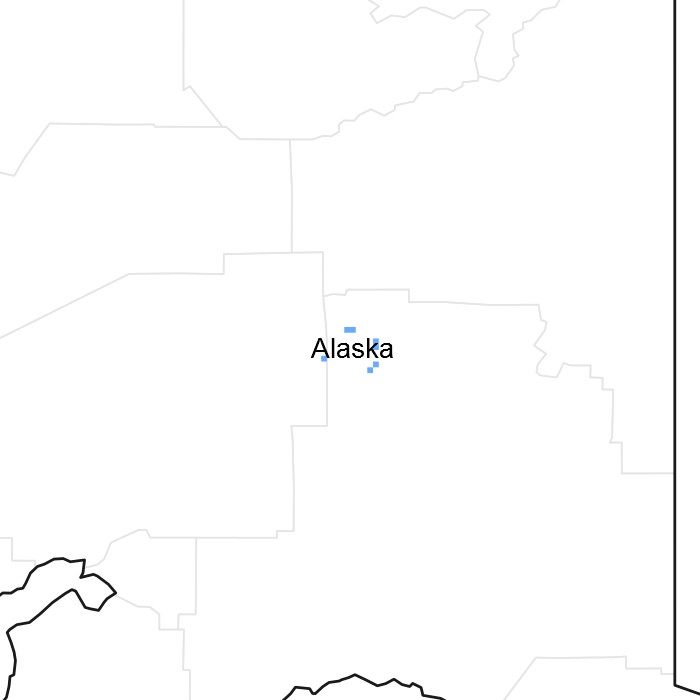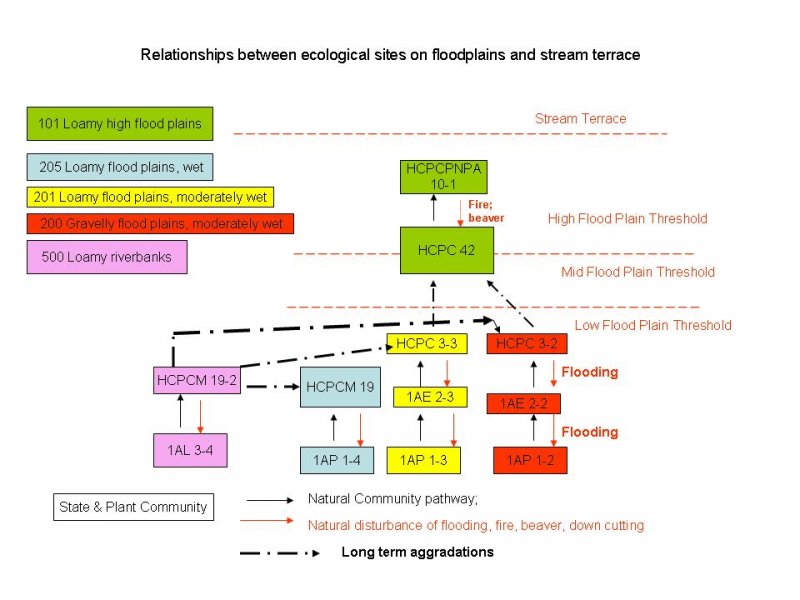Community 1.1
Low willow/herb scrub
Low willow/herb scrub is the correlated Potential Natural Plant Community on this site. In most places, this PNC is best characterized as a riparian association, which develops and persists under a regime of intermittent fluvial disturbance. In the Gulkana River Area, the upper elevational limit of this site, which corresponds with the upper elevational limit of the survey area within the river corridor, may be above the limit of tree growth. In this situation, the PNC probably represents the long term vegetative potential.
Low willow/herb scrub occurs from above treeline down into the forest zone, and successional status varies from potential to early seral vegetation depending on the site. Within the forest zone, most stands have uncommon to common Picea glauca and often Populus balsamifera seedlings, saplings, and small trees. With forest development, terrace height usually increases from channel migration and down-cutting. Flooding frequency decreases and the soils become better drained. Along the Middle Fork immediately below Dickey Lake, Low willow/herb scrub is potential vegetation or possibly seral to Low shrub birch scrub, which replaces the willow on stream terraces as terrace height increases and periodic flooding ceases.
In many places, Low willow/herb scrub occurs in close proximity with, and is transitional to, Low willow/water sedge scrub. Flooding is less frequent and of shorter duration in Low willow/herb scrub compared with Low willow/water sedge scrub. Also, surface ponding is less prevalent in Low willow/herb scrub.
Forest understory. Low willow/herb scrub consists of moderately open to closed willow 2 to 7 feet (0.6 to 2.1 m) in height with a moderately closed to closed herb layer. Low shrub canopy cover ranges from 40 to 95 percent. Dominant shrubs include Salix planifolia, S. barclayi, and often S. monticola. S. alaxensis forms an open tall shrub layer in some stands. Other low shrubs are relatively unimportant except for Potentilla fruticosa and Vaccinium uliginosum. In most stands, the herb layer is composed of a rich variety of species. Herb and dwarf shrub canopy cover is typically greater than 80 percent. Occasionally the herb layer is only sparse to open. Important herbs include Calamagrostis canadensis, Epilobium angustifolium, Equisetum spp., Mertensia paniculata, Polemonium acutiflorum, Swertia perennis, and often Carex aquatilis. Rubus arcticus and Salix reticulata are common dwarf shrubs in many stands. The ground surface is covered with feathermoss patches and herbaceous and woody litter.
Table 5. Ground cover
| Tree foliar cover |
1-7%
|
| Shrub/vine/liana foliar cover |
1-75%
|
| Grass/grasslike foliar cover |
1-20%
|
| Forb foliar cover |
1-25%
|
| Non-vascular plants |
15-35%
|
| Biological crusts |
0%
|
| Litter |
1-70%
|
| Surface fragments >0.25" and <=3" |
0%
|
| Surface fragments >3" |
1%
|
| Bedrock |
0%
|
| Water |
0%
|
| Bare ground |
1-2%
|
Table 6. Canopy structure (% cover)
| Height Above Ground (m) |
Tree |
Shrub/Vine |
Grass/
Grasslike |
Forb |
| <0.15 |
– |
– |
– |
– |
| >0.15 <= 0.3 |
– |
– |
– |
– |
| >0.3 <= 0.6 |
– |
– |
1-15% |
1-15% |
| >0.6 <= 1.4 |
– |
65-85% |
– |
– |
| >1.4 <= 4 |
– |
– |
– |
– |
| >4 <= 12 |
0-7% |
– |
– |
– |
| >12 <= 24 |
– |
– |
– |
– |
| >24 <= 37 |
– |
– |
– |
– |
| >37 |
– |
– |
– |
– |
Community 2.1
Tall feltleaf willow scrub
Tall feltleaf willow scrub consists of open to moderately closed willow 7 to 15 feet (2.1 to 4.6 m) in height. Lower layers include a sparse to moderately closed low willow layer and an open to moderately closed herb layer.
Feltleaf willow is a rapidly growing pioneering species on flood plains, and well adapted to frequent flooding and siltation. This species also appears to be relatively short lived and intolerant of canopy competition.
Tall feltleaf willow scrub is an early seral stage of flood plain succession in both the alder and willow zones. Within the willow zone, this cover type typically occurs as stands of small extent on gravelly and silty bars immediately adjacent to the channel. Within the alder zone, Tall feltleaf willow scrub along with Tall feltleaf willow/alder scrub occur spatially and successionally between Sparsely vegetated alluvium and the Thinleaf alder scrub cover types.
Riparian-Wetland Status Classification: Palustrine scrub-shrub, seasonally flooded, mineral (Cowardin et al. 1979); riparian
Forest understory. The tall willow is composed entirely of Salix alaxensis—canopy cover ranges from 25 to 70 percent. The low shrub layer ranges from 10 to 70 percent canopy cover and is composed primarily of S. barclayi and S. planifolia. Potentilla fruticosa and Vaccinium uliginosum are present in most stands, but other shrubs are generally of minor importance. The composition and abundance of the herb layer is variable, depending on stand location relative to the river channel and the frequency and duration of flooding. Herb cover ranges from 30 to 60 percent in most stands. Important herbs include Calamagrostis canadensis, Equisetum spp., Epilobium angustifolium, Hedysarum alpinum, Parnassia palustris, and Rubus arcticus. Leaf litter, woody debris, and small patches of moss cover most of the soil surface. Picea glauca and Populus balsamifera seedlings are occasional to common in many stands.
Table 7. Ground cover
| Tree foliar cover |
1-15%
|
| Shrub/vine/liana foliar cover |
1-25%
|
| Grass/grasslike foliar cover |
1-4%
|
| Forb foliar cover |
1-7%
|
| Non-vascular plants |
10-40%
|
| Biological crusts |
0%
|
| Litter |
15%
|
| Surface fragments >0.25" and <=3" |
0%
|
| Surface fragments >3" |
60%
|
| Bedrock |
0%
|
| Water |
0%
|
| Bare ground |
1%
|


